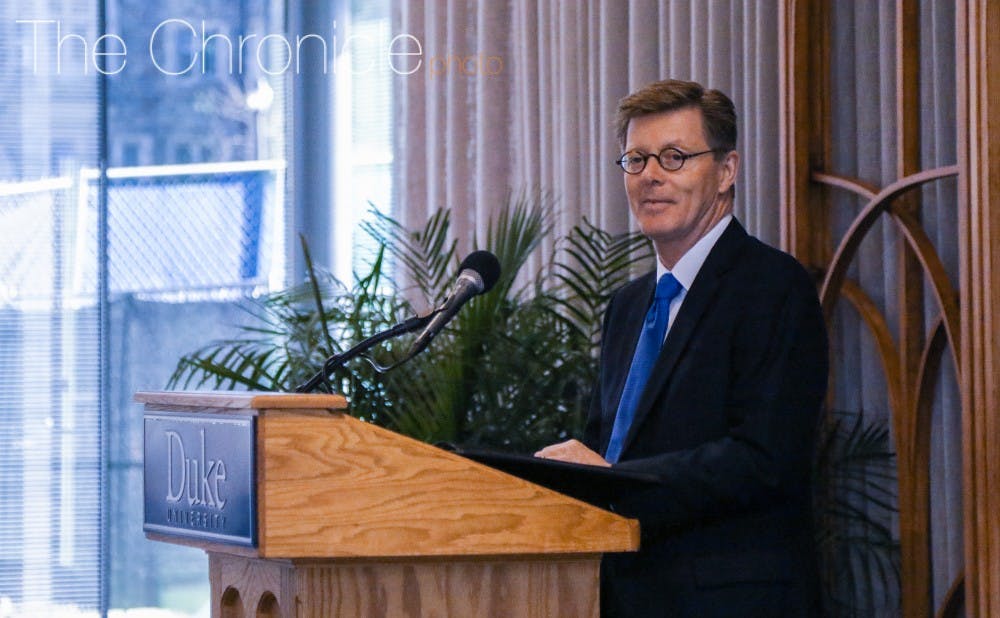Although his remaining days in Philadelphia are numbered, incoming President Vincent Price has still been productive on his current campus.
During his final months as provost of the University of Pennsylvania, Price has continued to advance a variety of the University’s “core priorities,” he wrote in an email. These include the living and learning experiences of students, improving faculty diversity, encouraging campus-wide dialogue on societal issues and developing new forms of teaching. Along the way, Price has also been preparing for his transition to the Duke presidency, which he will assume July 1, succeeding President Richard Brodhead.
“I greatly appreciate the warm welcome extended to me by President Brodhead and the Duke community, and I eagerly anticipate my move to Durham this summer,” Price wrote.
Faculty diversity and inclusion
Penn's Action Plan for Faculty Diversity and Excellence—launched in 2011 and updated in 2014—was designed to outline the initiatives, both new and ongoing, that would help Penn recruit, retain and mentor a more distinguished and diverse faculty. In January, Price wrote that his team was in the process of revising the plan in preparation for a progress report that would be released in the spring to Penn community.
In March, the Penn administration revised the plan ahead of a progress report that showed that the percentage of underrepresented minorities increased from 6.0 percent to 7.3 percent between Fall 2010 and Fall 2013, by far the largest increase over any other three-year period between Fall 2003 and Fall 2013. In the same three-year time-frame, the percentage of total female faculty at Penn increased from 30.1 percent to 31.5 percent.
Price said he has worked on promoting diversity among all officials of the Penn community.
“[Penn President Amy] Gutmann and I have placed particular emphasis on the importance of diversity and inclusion, not only among Penn faculty but also among our senior leaders,” Price wrote.
Innovations in teaching and learning
Under the leadership of Price—who served as the first chair of Coursera’s University Advisory Board—Penn’s engagement with online learning grew exponentially. Currently, the university offers more than a hundred courses on Coursera, reaching more than five million learners around the world in disciplines across Penn’s twelve schools.
Price also fostered the online learning innovations of various faculty on campus, including an integrated space on the first floor of Penn’s main library that opened in January. The space brings together several educational resources and facilities on campus, including the Center for Teaching and Learning, the Online Learning Initiative, the Center for Learning Analytics, digital media labs and a collaborative classroom.
Price wrote that he believes this “one-stop shop for all things teaching related” will catalyze even more collaboration and innovation for the benefit of Penn students and faculty.
“Educational work on new technological opportunities has consistently been one of my key priorities,” Price wrote.
Campus climate
This semester, Price and his administration brought together the joint administrative-student-faculty Task Force on a Safe and Responsible Campus Community in response to concerns about behavior that may undermine community, with particular attention placed upon gender-based discrimination.
Price wrote that the Task Force has been charged to recommend ways to further strengthen Penn’s efforts to foster a campus culture free of sexual harassment, substance abuse and other forms of problematic behavior, as well as ensuring that students are held accountable for living up to Penn’s code of student conduct.
“President Gutmann and I have made continuing efforts, with our excellent teams in the Office of University Life, to foster a campus climate and culture free of sexual harassment and sexual violence, to promote student psychological health and wellness, to address the problems caused by alcohol and other substance abuse and to reduce other kinds of behavior that undermine a safe and healthy environment while promoting community-building,” Price wrote.
Transition to Duke
Michael Schoenfeld, vice president for public affairs and government relations, said in a December interview that over the course of the Spring semester, Price would make periodic visits down to Durham to meet with faculty, students, staff and other key stakeholders of Duke. He added that during these visits, Price would be briefed on issues currently important to Duke and those that will become more important in the future.
“This is part of the effort to both introduce himself to Duke and introduce Duke to him,” he said.
Price wrote that many partners on Duke’s campus, under the leadership of Brodhead, are helping him gain a “fulsome understanding” of the campus and the community.
Schoenfeld described the transition from one president to another as a “bittersweet moment” for any institution. But he added that the University can always benefit from a different perspective—particularly that of Price, who, like Brodhead is a distinguished scholar and has successfully filled the position of a chief academic officer at another major university.
“I’m very pleased to continue to recognize President Brodhead and all of the great things he has done and focus on his legacy, but just as equally exciting is welcoming a new leader who will bring a different perspective,” Schoenfeld said.
Get The Chronicle straight to your inbox
Signup for our weekly newsletter. Cancel at any time.

